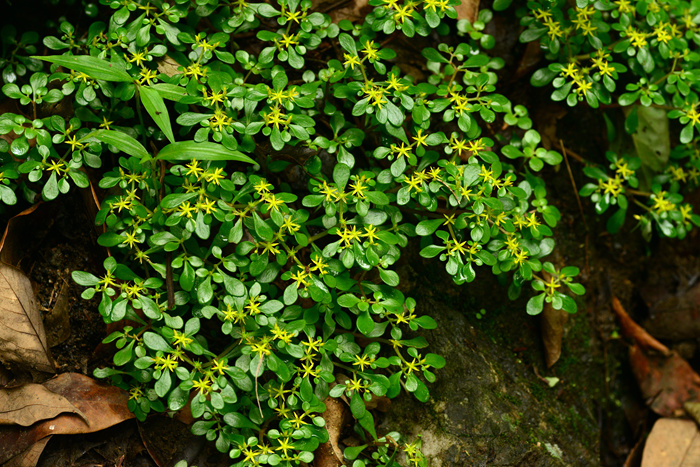- Scientific Name: Sedum makinoi Maxim.
- Ref: Bull. Acad. Imp. Sci. Saint-Pétersbourg, sér. 3, 32:487. 1888
- Synonyms: Sedum obovatum (Franch. & Sav.) Makino; S. subtile var. obovatum Franch. & Sav.
- English Common Name: Golden Japanese sedum
- Chinese Common Name: 圆叶景天 yuányè jǐngtiān
- Japanese Common Name: マルバマンネングサ [丸葉万年草] marubamannengusa
- Family: Crassulaceae
- Genus: Sedum
- Distribution: Shady moist forests in low mountain valleys. Anhui, Zhejiang [Japan].
- Photo: 06/09/2016, Yuhuang Hill, Hangzhou, Zhejiang
Herbs perennial. Stems basally prostrate and rooting at nodes, apically erect, 15-25 cm. Leaves opposite, pseudopetiolate; leaf blade obovate to obovate-spatulate, 1.7-2 × 0.6-0.8 cm, base tapered and shortly spurred, apex obtuse. Cyme 2-branched, 8-18 cm in diam.; bracts resembling stem leaves but smaller. Flowers sessile, unequally 5-merous. Sepals linear-spatulate, 2-3 × 0.7-0.8 mm, base shortly spurred, apex obtuse. Petals yellow, lanceolate, ca. 4.5 × 1.2 mm, apex obtusely acuminate. Stamens 10; antesepalous ones subequaling petals; antepetalous ones shorter than petals. Nectar scales oblong-spatulate, ca. 0.6 mm. Carpels lanceolate, ca. 5 mm, base connate for ca. 1 mm. Styles ca. 1 mm. Follicles obliquely divergent. Seeds ovoid, small, minutely mammillate. Fl. Jun-Jul. (Flora of China)
